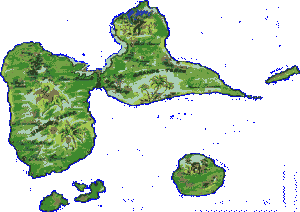Subaquatic life








|
Little butterfly lost among all the Caribbean islands, Guadeloupe, used to be populated first by the calm Arawak indians and then by the dangerous cannibals, before being a French department. Colonized by the France in 1635, 142 years after being discovered by Christophe Colomb, it was an essential place for trade.
|

|

|
Guadeloupe is formed by 2 islands separated by a small arm of sea : the salted river.
Grande Terre, on the East, is a wide plain;
Basse Terre, on the West, is mountainous and volcanic, covered by a tropical vegetation.
|
On the buccaneering steps...

Very differents from the pirats that behind their Jolly Roger black flag decorated with skull and tibias, pillaged every articles of value, the buccaneers or corsairs used to attack Spanish or British ships, that were France's ennemies.
They played an important part during the wars of the Revolution and of the Empire (1793-1814).
In theis part of the world where Old and New lands' stories are melted, nature a very rich and contrasted :
Guadeloupe or Emerald Island because of the exceptionnal colour of the sea there.
A tropical vegetation with tree ferns and many other species are forming lush forests that cover the montains and the volcanos of the island.
Add to this paradise wonderful white sand beaches (or black sometimes because of the volcanos), waterfalls, canes sugar plantations and of course, the rum...
... and the diving, the main reason of this trip.
Here, diving is easy; in the warm crystal water and we usually dive between 10 and 20 metres) except between the South of "Basse Terre" and the "Saintes", the dive ta 30 metres of depth requires a high level in diving and a serious training.
Here, no shark or big ray but, an abundance of sponges and corals creates an imposing spectacle for divers where groupers and barracudas as well as angelfishs and turtles can also be found.
Adress :
|